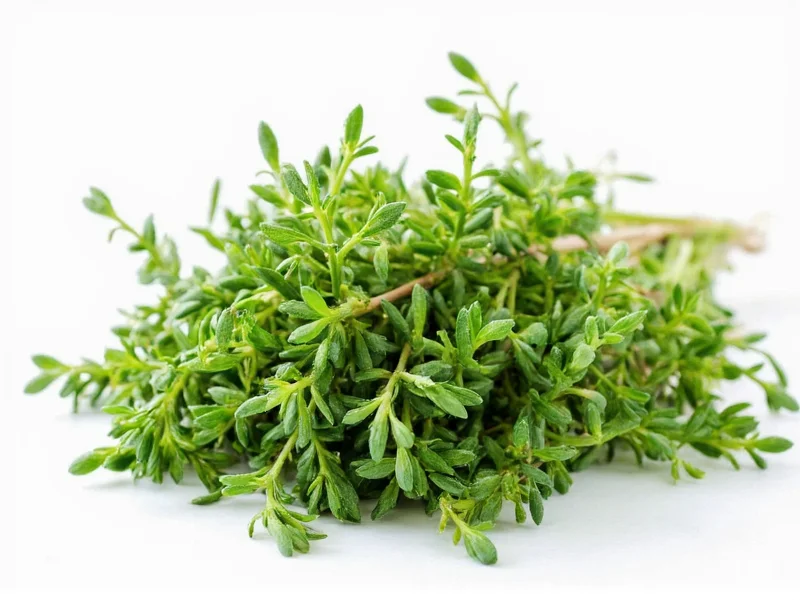Running out of thyme while cooking doesn't have to ruin your recipe. As an experienced culinary professional with two decades of herb expertise, I've tested countless substitutions that maintain dish integrity when thyme is unavailable. Understanding thyme's unique flavor profile—earthy with subtle floral notes and a hint of mint—is crucial for selecting the right replacement.
Understanding Thyme's Flavor Profile
Thyme (Thymus vulgaris) delivers a complex flavor that combines earthiness with subtle lemon and mint undertones. Its moderate intensity makes it versatile across meat dishes, stews, and vegetable preparations. When seeking thyme alternatives, consider whether your recipe calls for fresh (more delicate flavor) or dried (more concentrated) thyme, as substitution ratios differ significantly.
Top Thyme Substitutes Ranked by Effectiveness
Not all herb substitutions work equally well. These alternatives have been rigorously tested across various cooking applications:
| Substitute | Ratio (vs. Thyme) | Best For | Flavor Notes |
|---|---|---|---|
| Rosemary | 3/4 amount | Roasted meats, potatoes, hearty stews | Stronger pine-like flavor; use less to avoid overpowering |
| Oregano | 3/4 amount | Tomato-based dishes, Italian cuisine, grilled vegetables | More pungent; excellent for Mediterranean recipes |
| Marjoram | 1:1 ratio | Egg dishes, light sauces, poultry | Sweeter, milder cousin of oregano; closest flavor match |
| Herbes de Provence | 1:1 ratio | French cuisine, roasted vegetables, marinades | Contains thyme plus complementary herbs; check blend |
| Savory (summer) | 1:1 ratio | Bean dishes, stuffings, soups | Peppery notes; traditional in European cooking |
Detailed Substitution Guide for Specific Applications
For Poultry Dishes
When preparing chicken or turkey recipes that call for thyme, marjoram provides the closest flavor match with its sweet, floral notes. Use equal amounts of dried marjoram for dried thyme. For fresh applications, substitute 1 tablespoon fresh marjoram for 1 tablespoon fresh thyme. If marjoram isn't available, combine equal parts oregano and basil to approximate thyme's complexity in what can i use instead of thyme for chicken scenarios.
For Soups and Stews
Heartier liquid-based dishes benefit from rosemary as a thyme replacement, though you should use only three-quarters of the amount called for. The woody notes of rosemary hold up well during long cooking times. For tomato-based soups specifically, oregano makes an excellent substitute at a 3:4 ratio (¾ tsp oregano per 1 tsp thyme). Remember that dried herbs generally require 15-20 minutes of simmering to fully release their flavors when considering dried thyme replacement options.
Fresh vs. Dried Herb Substitutions
Many home cooks don't realize that fresh and dried herbs aren't interchangeable at 1:1 ratios. When exploring what can i use instead of fresh thyme, remember these critical conversion guidelines:
| If Recipe Calls For | Substitute With | Conversion Ratio |
|---|---|---|
| 1 tsp dried thyme | Fresh rosemary | 1½ tsp |
| 1 tbsp fresh thyme | Dried oregano | ¾ tsp |
| 1 tsp dried thyme | Fresh marjoram | 1 tbsp |
| 1 tbsp fresh thyme | Dried herbes de Provence | 1 tsp |
Creative Herb Blending Techniques
Sometimes a single herb won't adequately replace thyme's complex profile. For recipes where thyme plays a starring role, try these professional blending techniques:
- Mediterranean Blend: Combine ½ tsp oregano + ¼ tsp basil + ¼ tsp parsley (perfect for tomato-based dishes)
- French Kitchen Staple: Mix ½ tsp marjoram + ¼ tsp tarragon + ¼ tsp chives (ideal for sauces and egg dishes)
- Hearty Roast Solution: Blend ½ tsp rosemary + ¼ tsp sage + ¼ tsp parsley (excellent for meats and root vegetables)
These combinations address what herb can replace thyme in specific culinary contexts while maintaining authentic flavor profiles. Add blended substitutes early in cooking to allow flavors to meld properly.
When Substitutions Won't Work
Certain recipes rely so heavily on thyme's unique chemistry that substitutions fall short. Traditional bouquet garni bundles, certain French stews like coq au vin, and some herb-infused vinegars lose essential character without genuine thyme. In these cases, consider these alternatives:
- Make a quick trip to the grocery store—many stores now offer single-serve herb packets
- Check local farmers markets for fresh herb bundles
- Grow your own thyme plant (thrives indoors with minimal care)
- Invest in high-quality dried thyme (lasts 1-2 years when stored properly)
Proper Storage for Thyme Alternatives
Maximize the shelf life of your herb substitutes with these professional storage techniques:
- Dried herbs: Store in airtight containers away from light and heat; maintain potency for 1-2 years
- Fresh herbs: Trim stems, place in water-filled jar, cover loosely with plastic bag, refrigerate (lasts 1-2 weeks)
- Freezing: Chop fresh herbs, mix with olive oil, freeze in ice cube trays for ready-to-use portions
Understanding proper storage extends what can i use instead of thyme options by ensuring your herb collection remains viable. Label all containers with purchase dates to track freshness.
Final Considerations for Successful Substitutions
The key to successful thyme substitution lies in understanding your specific recipe's requirements. For delicate dishes like fish or egg preparations, choose milder substitutes like marjoram. Heartier applications like beef stews tolerate stronger alternatives like rosemary. Always add substitutes gradually, tasting as you go—remember that dried thyme replacement options typically require less quantity than fresh.
Professional chefs often keep a small selection of essential dried herbs on hand specifically for substitution emergencies. Building this pantry safety net addresses the common cooking dilemma of what can i use instead of thyme when you're mid-recipe and realize your thyme has lost potency or run out entirely.











 浙公网安备
33010002000092号
浙公网安备
33010002000092号 浙B2-20120091-4
浙B2-20120091-4